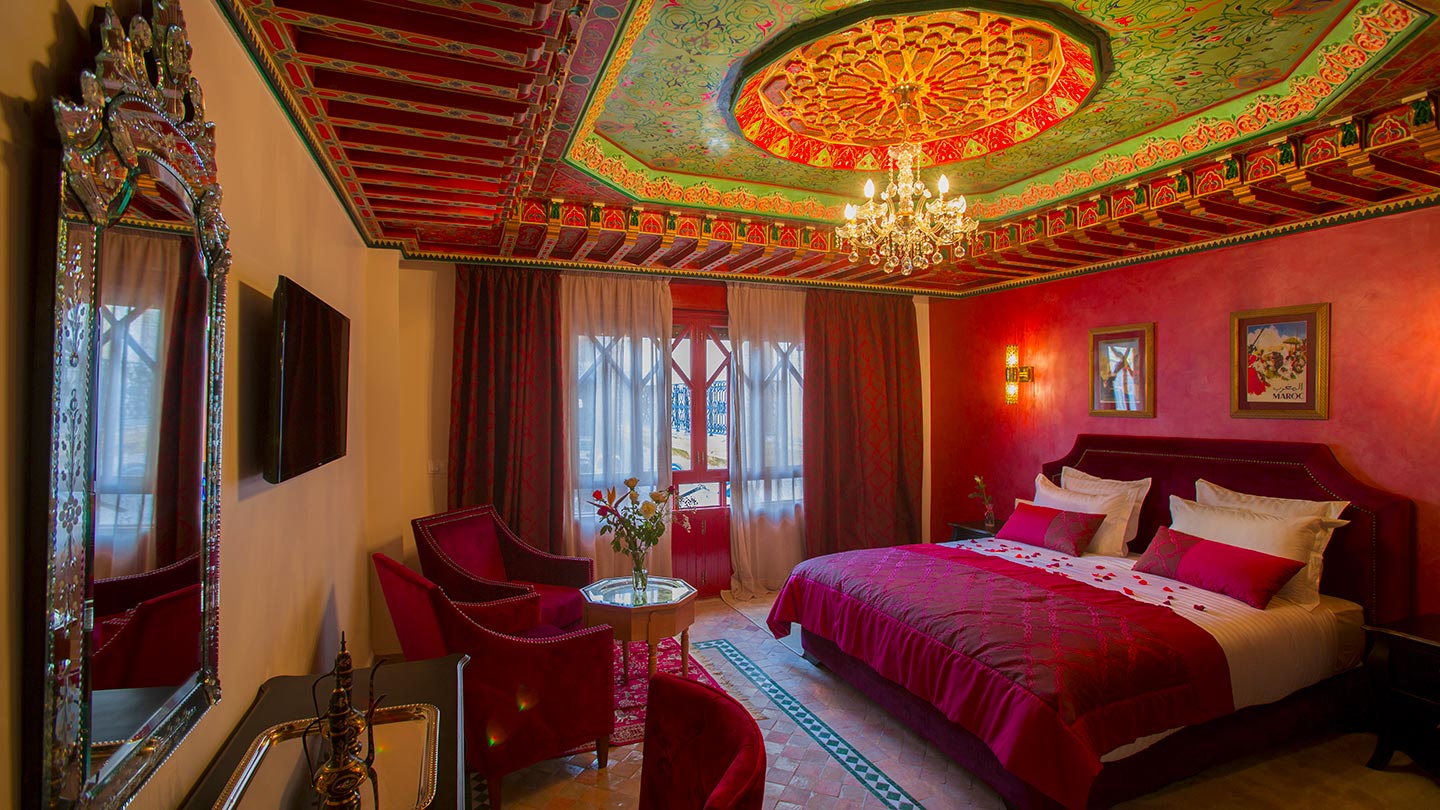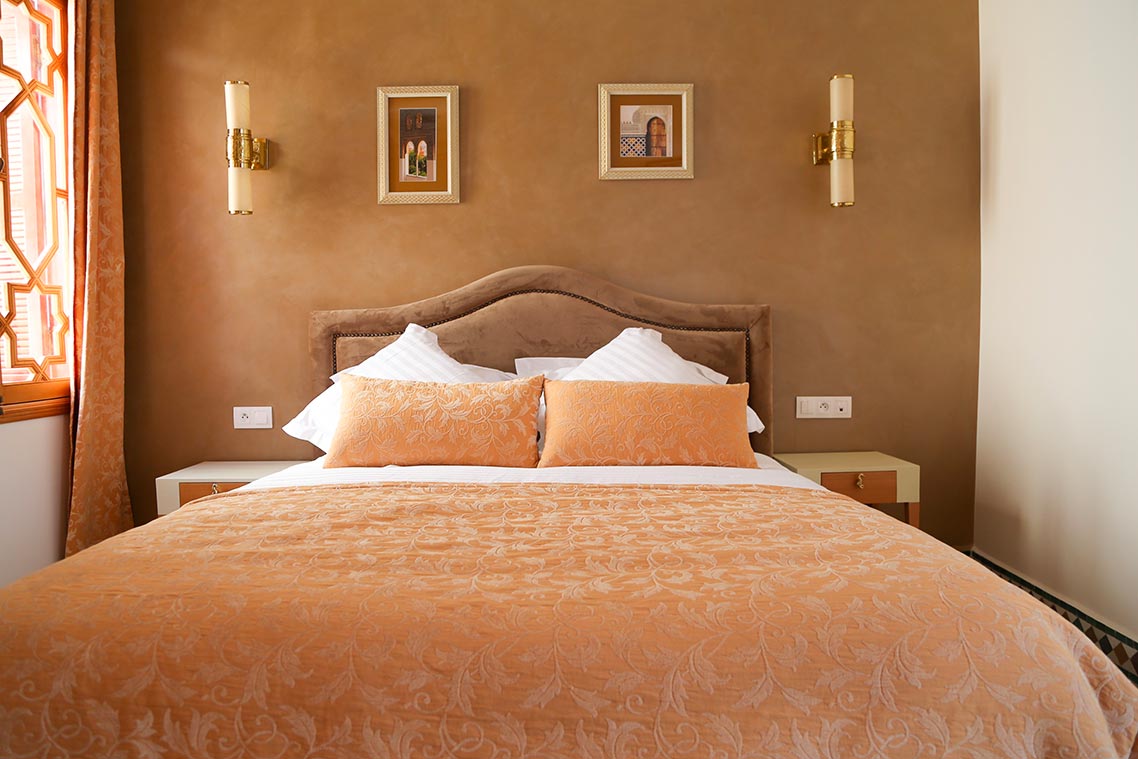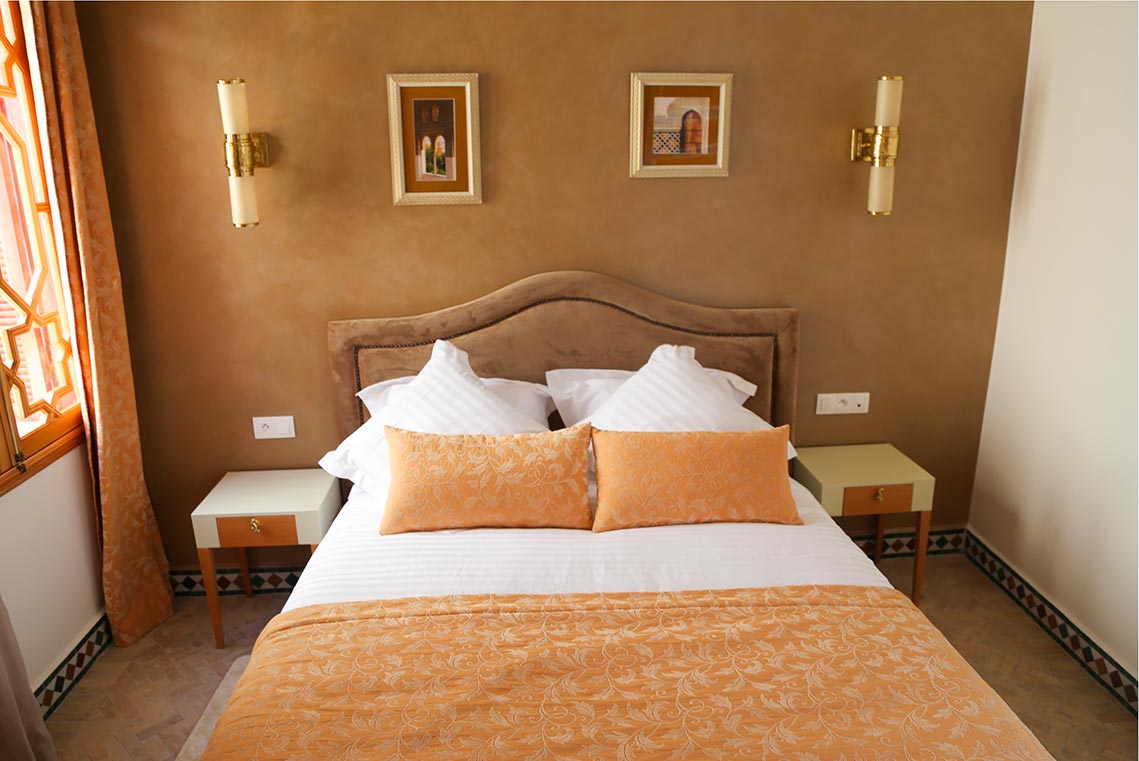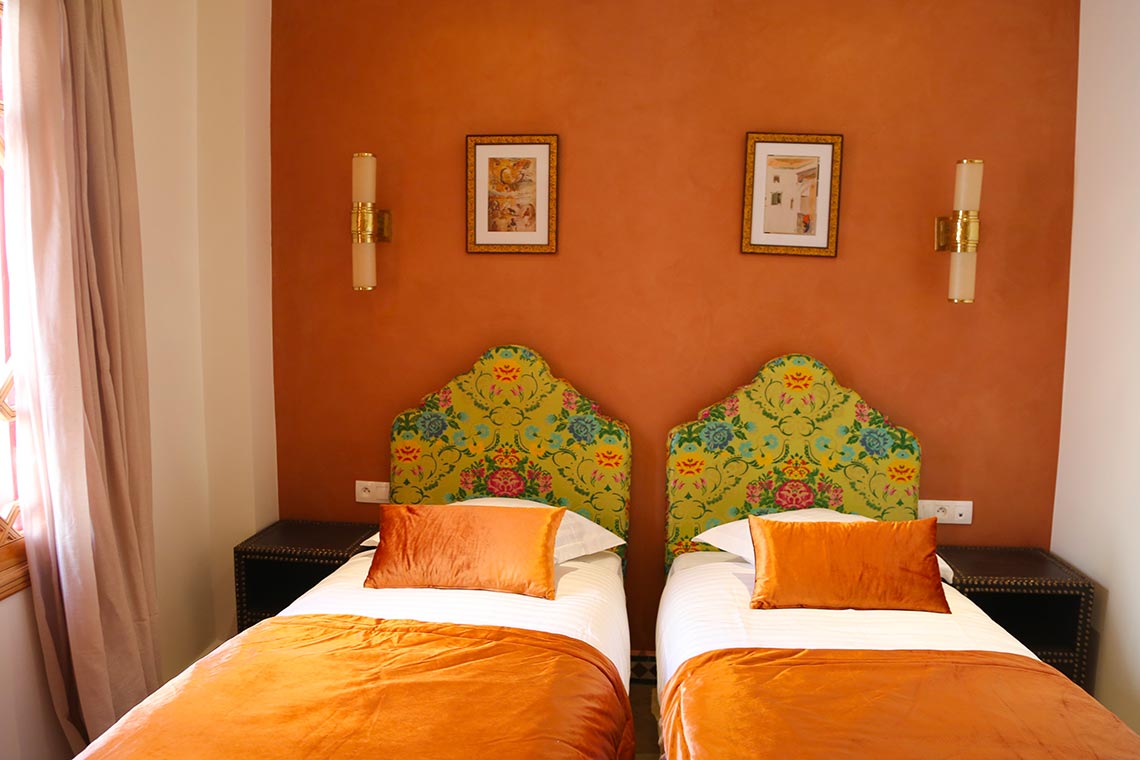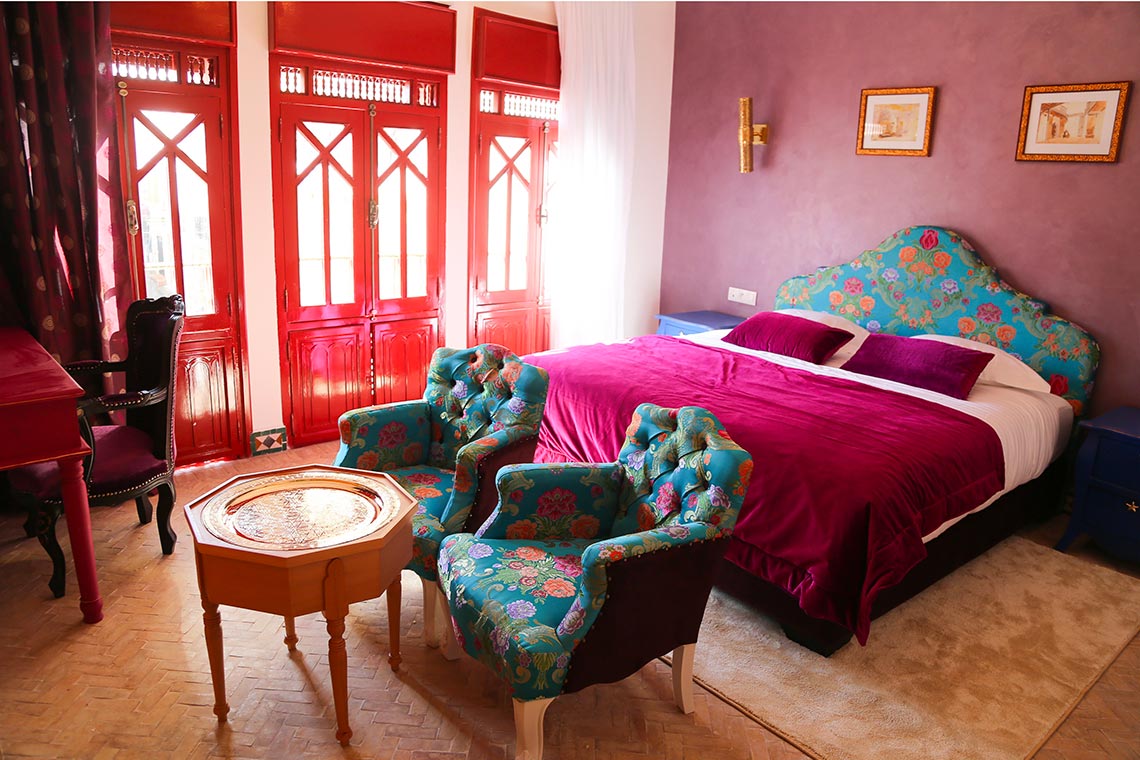Rooms :
-
 The Sultan Suite
The Sultan Suite 
-
 The Zahia Suite
The Zahia Suite 
-
 The Kasbah Room
The Kasbah Room 
-
 The Dar Baroud Room
The Dar Baroud Room 
-
 The Massinissa Suite
The Massinissa Suite 
-
 The Matisse Suite Room
The Matisse Suite Room
-
 The Petit Socco Room
The Petit Socco Room
-
 The World’s Culture Suite
The World’s Culture Suite 
-
 The Dar El Mendoub Room
The Dar El Mendoub Room
-
 The Ibn Battouta Luxe Room
The Ibn Battouta Luxe Room
-
 The Paul Bowles Room
The Paul Bowles Room
-
 The 9th of April Room
The 9th of April Room 
-
 The Tangerine Room
The Tangerine Room
-
 The Alhambra Room
The Alhambra Room 
-
 The Eugène Delacroix Luxury Suite
The Eugène Delacroix Luxury Suite
-
 Chambre Choukri
Chambre Choukri 
The Sultan Suite
It is a luxuriously decorated suite worthy of a Sultan, incorporating an Arabic-Moorish Zouak decoration at the ceiling and an Italian style shower with Basque in Zallej. It is the symbol of the most important person in an Arab-Muslim country; it represents the higher authority. This suite will make you dream about a bourgeoisie stay of a person of note, with its related terms of nobility.
The Zahia Suite
The name of the palace reveals the symbol of Hajja Zahia, wife of Haj Hassan El Yassini Sabtaoui, president of the Zahia Palace society. A lady of great charisma, profane of Tarika Soufia Allaoui, leader of the Allaouia women’s group in Tangier. A lady known for her hospitality and her social and associative spirit.
The Kasbah Room
A name given to a building which is the symbol of the southern adobe architecture, especially in the region of Ouarzazate, known as the thousand Kasbahs’ road. The Grand Ouarzazate is a high place rich in multiple architectural heritages in adobe, including the Bourges, towers, Ksours and Kasbahs. Originally, the Kasbah is a place of meeting for soldiers and a place of command and monitoring for tribes, such as Kasbah of Ait Benhaddou, Kasbah of Tadla and Kasbah of Taourirt. It is also the place where the Pashas and the Chiefs of the tribes resided. It was used by the protectorate as a rampart of meetings and command. The Makhzen also uses these places as centers of meetings of Caïds, notables, etc.
The Dar Baroud Room
Dar Baroud is an historical district of Tangier, located at the East of the Medina, facing the port. The district of Dar Baroud occupies 7 Ha and has 4,196 habitants, with a density of nearly 600 Hts / Ha.
Dar Baroud was a place of arms and a parade ground for soldiers. It represents today the symbol of the history of the city. This historical place of the Medina of Tangier is embellished with ancient cannons that still existing in its hall. Dar Baroud is stretching along the port at the East side of Medina, overlooking Continental Hotel. The latter received the visit of hosts as illustrious as Churchill or the Duke of Edinburgh...
The Massinissa Suite
Massinissa is a king quoted in the Bible. He lived three thousand years before Jesus, when the Imazighens were in contact with the Egyptian kingdoms... Massinissa is the Berber king who will later make history. He managed to reunite all of Numidia and reached an important state of civilization. Massensen, as named in the Amazigh language, manages to develop an immense territory and exports wheat and cereals to Rome and Greece. The Amazigh king also appropriates the modern attributes of sovereignty as the minting of money and the development of monetary circulation. Under his reign, the exchanges between cities and countryside knew a remarkable development. The famous phrase "Africa belongs to Africans" was first pronounced by King Massinissa.
The Matisse Suite
The famous painter Matisse also came to Tangier and immortalized its charm through his sublime paintings. He stayed at Villa de France Hotel, where he discovered the light and landscapes that Delacroix had described, especially the beautiful views from the windows of the Hotel. The Californian Richard Diekebon is also among the famous artists bewitched by the magic of the Strait’s City. Matisse, like other Western artists and painters, had his cup of coffee at the famous Café Central at Petit Socco, the location of Zahia Palace.
The Petit Socco Room
Crossing the Siaghine street, you reach the Petit Socco, or the heart of the city, surrounded by coffee shops and hotels and where all the transactions of that time were made with all the currencies of the world, cosmopolitan par excellence and place of appointment of celebrities of all kinds. We could meet there writers like Paul Bowels, painters like Delacroix and Matisse, and – later – Jean Genet, the Rollins Stones, Liz Taylor, the Beatles, knowing that this list is not exhaustive. This is the place where Zahia Palace is located.
The World’s Culture Suite
This suite responds to the aspect of Tangier Al Alia (the higher), a crossroads of cultures and civilizations, a place of international meetings, known as the place of the world’s cultures, with its international aspect and its character of cohabitation between different religions and cultures. It is the city of the world’s cultures par excellence, where the three religions coexist, since Mosque, Church and Synagogue are side by side in the medina.
The Dar El Mendoub Room
This room brings the Mendoubia to mind; the former seat of the governor, representative of the Sultan in Tangier at the international and colonial eras. This mythical building, whose courtyard is a huge garden, incorporates now the seat of the Commercial Court of Tangier. The decorative elements of this room remind us of this time.
The Ibn Battouta luxe Room
The most famous Tangerian figure in the history of the Strait’s City is undoubtedly Abu Abdullah Muhammad Ibn Abdullah Al Tanji, better known as “Ibn Battouta” (1304-1369). This famous explorer had traveled more than 120,000 km in 29 years of travel that brought him from Timbuktu in the South to Bulghar (Russia) in the North, before crisscrossing the Far East. His memorable stories were compiled by Ibn Juzayy in a book called Rihla (The Travel).
The Paul Bowles Room
Paul Bowles, the American-Tangerian musician, writer, artist and novelist.
The American, born on December 30th 1910, and the last close to the beat generation, to which he did not belong strictly speaking, was settled in Tangier in 1947, after living in Ceylon, South America and Paris. He died on Thursday in the city of Tangier at the age 89.
The 9th of April Room
The 9th of April square is the beating heart of the medina of Tangier. This historical place acquired these letters of nobility during the visit of His Majesty Mohammed V to Tangier on the 9th of April of 1947. This historical crossroads was called Grand Socco or Souk Dbarra (that is to say, the souk outside the walls of the Medina). It was used as a connection point with the ancient city through Bab El Fahs. This place was also the main square, typically Andalusian, surrounded by coffee shops, small restaurants and spice or citrus shops which decorate the center of the city.
The Tangerine Room
(Tangier’s bitter orange): Tangerine (Citrus- tangerine) is a fruit of the citrus family, very close to mandarin. Its peel is darker and it is peeled easily than mandarin. Its name comes from Tangier, which was the main port of its export. The Tangerine room is inspired from this historical fruit.
The Alhambra Room
The Alhambra is a palace which was called ‘Casa Real’ (House of the King or Alcazar, where the collective life of the Nasrid kings took place). This palace is consisting of three palaces, built independently, each one having a particular function. This was where the official and family life of the royal families took place. The complex does not occupy exactly the center of the palatial city of Alhambra. It occupies a side part. The construction of these three palaces did not take place simultaneously, but over an extended period of time.
The Eugène Delacroix Luxury Suite
Delacroix the painter and traveler is the author of Carnets du Maroc (the notebooks of Morocco) in 1832. He was in love with Tangier as most of the artists of his time. The National Museum Eugène Delacroix specifies that it is on January 25th 1832 that the mission arrives in Tangier. In Journal de Delacroix T.1 preceded by a study on the master by Mr. Paul Flat; notes and clarifications by Mr. Paul Flat and Mr. René Piot, published in Paris, between 1893-95, by Plon-Nourrit, a copy of which - scanned in text mode - is available on the website openlibrary.org, Eugène Delacroix specified that: “At nine o’clock, we anchored in front of Tangier. I enjoyed with pleasure the aspect of this African city. It was very different; when, after the usual signals, the consul arrived on board in a boat with about twenty black, yellow and green marabouts, who began to climb like cats throughout the building and dared to join us. I could not take my eyes off these singular visitors.” (Corresp., t.1, page 173).
Mohamed Choukri
Mohamed Choukri was born on July 15th 1935 in Beni Chiker at the Riff, in Morocco. Driven by misery, his family moved in 1942 to Tangier, but the young Mohamed fled and became a street child. Illiterate and speaking only Berber, he learns to read and write in Arabic at the age of twenty and becomes a teacher, then a professor. It was only then that the young man starts writing. In the 60s, he met the writer Paul Bowles who was behind his first publication: Violence on the Beach. A new publication was edited in 1966 in a literary review. He met, at the same time, Jean Genet and Tennessee Williams. It was in 1973 that Mohamed Choukri became a world-famous writer with the publication of his Roman “For Bread Alone”. In France, they didn’t discover the book and its author until 1980, when Tahar Ben Jelloun translated it into French. Choukri continued his autobiography with Time of Mistakes (1992) and Faces (1996)…
